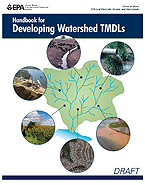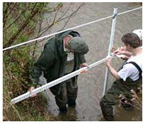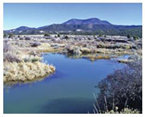Watershed News
January 2009
|
Watershed News is a publication of EPA's Office of Wetlands, Oceans and Watersheds. It is designed to provide timely information to groups working at the watershed level.
![]()
In this month's newsletter
1) NOAA Bay Watershed Education and Training (B-WET) Program2) Lake Erie Coordinated Science and Monitoring
3) FY09 RFP for Development and Implementation of the Chesapeake Bay Innovative Nutrient and Sediment Reduction Program
4) West Coast Estuaries Initiative
5) Community Action for a Renewed Environment (CARE) Program
6) Agencies Revise Guidance to Protect Wetlands and Streams
7) Sanitary Survey Guidance Manual for Ground Water Systems
8) Finalist for Targeted Watersheds Grants to Improve the Gulf of Mexico
9) Preserve America's Waterways (PAWs) Launches Youth Efforts to Protect Our Nations Waterways
10) American Water Resources Association (AWRA) 2009 Summer Specialty Conference Call for Abstracts
11) Announcing California's Water Resource Control Boards - NPS Encyclopedia
12) EPA Publishes Draft Handbook for Developing Watershed Total Maximum Daily Loads (TMDLs)
13) WARSSS - Watershed Assessment of River Stability and Sediment Supply: A Methodology for Assessing Sediment Problems in Rivers and Streams
14) Nutrioso Creek, Arizona
15) 8th Annual New Partners for Smart Growth Conference
16) 5th National Conference for Nonpoint Source and Stormwater Outreach: "Achieving Results with Tight Budgets"
17) World Environmental and Water Resources Congress
18) Nonpoint Source Pollution Conference
19) River Network's National River Rally
20) StormCon '09
Funding Opportunities
NOAA Bay Watershed Education and Training (B-WET) Program
NOAA B-WET is an environmental education program that promotes locally relevant, experiential learning in the K-12 environment. Funded projects provide meaningful watershed educational experiences for students, related professional development for teachers, and helps to support regional education and environmental priorities in the Pacific Northwest, the northern Gulf of Mexico and New England. Approximately $2 million is available under this announcement. Applications are due on January 26, 2009.
Lake Erie Coordinated Science and Monitoring
EPA's Great Lakes National Program Office is requesting application packages for projects advancing Lake Erie Priorities under the project categories: Lake Erie Western Basin Algal Bloom Study, Lake Erie Central and Eastern Basin Studies of nearshore/offshore nutrient fluxes and Interactions, Lake Erie Bioavailable Phosphorus Studies, Lake Erie basin tillage and nutrient management study and Lake Erie Basin On-Farm Demonstration Projects. An estimated $500,000 is expected to be awarded under this announcement for an estimated 5-10 grants or cooperative agreements ranging from approximately $30,000 - $150,000 each. Proposals are due on February 2, 2009.
FY09 RFP for Development and Implementation of the Chesapeake Bay Innovative Nutrient and Sediment Reduction Program (PDF) (27 pp, 190K, About PDF)
EPA's Chesapeake Bay Program Office is announcing a request for proposals for a recipient to develop and implement the FY 2009 Chesapeaks Bay Innovative Nutrient and Sediment Reduction Program. This RFP sets forth the process that will be used for competitively selecting a grant recipient that will develop and implement the Program with the primary task of making competitive subawards to eligible organizations to meet the specified expected environmental results. An estimated $6 million to $6.5 million is expected to be available for award under this announcement depending upon funding availability, the amount of FY 2009 funds ultimately received, and the quality of proposals received. EPA plans to award one agreement under this announcement. Proposals are due by February 6, 2009.
West Coast Estuaries Initiative
EPA Region 10 is soliciting proposals to support the protection and restoration of high value, coastal resources in areas threatened by growth pressure. Through comprehensive watershed protection and management approaches, these grant funds will assist local and tribal governments in managing land uses while protecting watershed functions and values. Successful projects will match proposed activities to the appropriate watershed scale to ensure environmental results. An estimated $2.8 million is available under this announcement. Proposals are due February 19, 2009.
Community Action for a Renewed Environment (CARE) Program

News
Agencies Revise Guidance to Protect Wetlands and Streams
EPA and the Department of the Army are issuing revised guidance to ensure America's wetlands, streams and other waters are better protected under the Clean Water Act (CWA). The guidance clarifies the geographic scope of jurisdiction under the CWA. The revised guidance replaces previous policy issued in June 2007 and clarifies a June 2006 Supreme Court decision in Rapanos v. United States regarding the scope of the agencies' jurisdiction under the CWA. The guidance follows the agencies' evaluation of more than 18,000 jurisdictional determinations and review of more than 66,000 comments.
Sanitary Survey Guidance Manual for Ground Water Systems
EPA has developed the Sanitary Survey Guidance Manual for Ground Water Systems to provide states, tribes, and other primacy agencies with a brief review of the sanitary survey regulatory provisions of the Ground Water Rule (GWR). The manual describes the details of a comprehensive sanitary survey, addressing the minimum eight sanitary survey elements required under the GWR, and provides specific examples of what constitutes a significant deficiency. Sanitary surveys are a proactive public health measure that can identify deficiencies in drinking water systems before any contamination of the public water supply occurs. The manual also helps surveyors understand how each set of Safe Drinking Water Act regulations applies to sanitary surveys.
Finalist for Targeted Watersheds Grants to Improve the Gulf of Mexico
A total of $3.7 million will assist ten selected organizations in reducing pollutants that contribute to the oxygen-depleted zone in the northern Gulf of Mexico. The ten finalists will implement agricultural conservation measures, restore wetlands and riverbanks, monitor water quality, and create a variety of innovative, market-based programs to improve water quality. More information about the finalists and their projects can be found on the Water Quality Trading webpage. These projects under the EPA's Targeted Watersheds Grants Program will reduce the sources of pollutants, including runoff from developed land, soil erosion, agricultural fertilizers, and sewage and industrial discharges. Parts or all of 31 states drain into the watershed that flows into the Gulf of Mexico.
Preserve America's Waterways (PAWs) Launches Youth Efforts to Protect Our Nations Waterways


 provides a database of service projects and ways to get involved. It also allows organizations to log their service hours to contribute to the one million hour goal. Watershed
groups and other conservation organizations may find some great volunteer support through this exciting initiative!
provides a database of service projects and ways to get involved. It also allows organizations to log their service hours to contribute to the one million hour goal. Watershed
groups and other conservation organizations may find some great volunteer support through this exciting initiative!
American Water Resources Association (AWRA) 2009 Summer Specialty Conference Call for Abstracts

The deadline to submit an abstract for the 2009 AWRA Summer Specialty Conference Adaptive Management of Water Resources II is January 26, 2009. The conference will be held June 29-July 1, 2009 at Snowbird Ski & Summer Resort, Snowbird, UT.
Announcing California's Water Resource Control Boards - NPS Encyclopedia
The NPS Encyclopedia is a free on line reference guide designed to facilitate a basic understanding of nonpoint source (NPS) pollution control and to provide quick access to essential information from a variety of sources by providing direct hyperlinks to resources available on the web. The purpose of this on line resource guide is to support the implementation and development of NPS total maximum daily loads (TMDLs) and watershed (action) plans with a goal of protecting high quality waters and restoring impaired waters.
EPA Publishes Draft Handbook for Developing Watershed Total Maximum Daily Loads (TMDLs)

The draft document identifies the issues for practitioners to consider and tools and resources that can help them when planning for and developing watershed TMDLs. It also identifies the benefits of developing watershed TMDLs, as well as the challenges and ways to address them. Examples, tips and resources provide further support for TMDL practitioners in understanding how to develop watershed TMDLs to cost-effectively develop allocations to restore impaired waters. Finally, the draft document evaluates the connections between watershed TMDLs and other water programs and identifies opportunities for integrating watershed TMDLs and their results into other watershed management efforts, such as monitoring, watershed planning, watershed-based permitting and water quality trading.
Watershed Tool of the Month
WARSSS - Watershed Assessment of River Stability and Sediment Supply: A Methodology for Assessing Sediment Problems in Rivers and Streams

Spotlight: Watersheds at Work
Nutrioso Creek, Arizona

Upcoming Conferences and Workshops
8th Annual New Partners for Smart Growth Conference

January 22-24, 2009. Albuquerque NM. The Local Government Commission will host the conference, which is expected to draw a multidisciplinary audience of local elected officials, city and county staff, landscape architects, developers and builders, planners, transportation professionals, public health professionals, architects, urban designers, parks and recreation professionals, school superintendents, environmentalists, crime prevention professionals, bicycle and pedestrian advocates, advocates for social equity and affordable housing, and all others committed to building safer, healthier, and more livable communities everywhere.
5th National Conference for Nonpoint Source and Stormwater Outreach: "Achieving Results with Tight Budgets"
May 11-14, 2009, Portland, Oregon. The 5th National Conference for Nonpoint Source and Stormwater Outreach will provide practitioners from around the country the opportunity to learn and share ideas on developing and implementing nonpoint source and stormwater outreach strategies that produce positive, measurable outcomes, comply with NPDES requirements, and can be successfully implemented with modest budgets. The conference will serve local, regional, state and federal professionals tasked with educating various audiences on nonpoint source pollution, stormwater pollution, watershed protection and promoting sustainable behavior changes in challenging economic times.
World Environmental and Water Resources Congress

May 17-21, 2009. Kansas City, MO. Organized by EWRI and ASCE, this Congress' central theme is the great rivers of the world and the engineering challenges of balancing environmental and development issues while achieving a sustainable future. It is imperative that those working on the front lines - at the environmental/water engineering nexus - share insights from research and practical experience in the field to generate best practices for the future on issues such as river system management, environmental issues, watershed management and restoration, dam safety, hydraulic structures, and so much more.
Nonpoint Source Pollution Conference

May 18-20, 2009. Portland, ME. Organized by New England Interstate Water Pollution Control Commission. The three-day conference brings together all those in New England and New York State involved in NPS pollution management, including participants from state, federal, and municipal governments, private sector, academia, and watershed organizations.
River Network's National River Rally

May 29-June 1, 2009, Baltimore, MD. Baltimore, Maryland will play host to the 10th National River Rally. And, like the nine River Rallies preceding it, River Rally 2009 is sure to be an event you won't want to miss. Highlights include:
- A series of intensive, 4-hour workshops on Friday afternoon
- Over 70 additional workshops covering topics of interest to staff, volunteers and board members of river conservation organizations
- Office hours, mentoring sessions and real life, in-person conversations with funders and exhibitors
- The River Heroes Banquet
StormCon '09

August 16 - 20, 2009. Anaheim, CA. In addition to serving municipal and government professionals, StormCon offers sessions on sediment and erosion control practices for contractors, and techniques for special sites, such as airports and ports. StormCon offers non-technical stormwater sessions that will benefit those completely new to stormwater, as well as advanced sessions for seasoned professionals.
![[logo] US EPA](https://webarchive.library.unt.edu/eot2008/20090115170244im_/http://www.epa.gov/epafiles/images/logo_epaseal.gif)